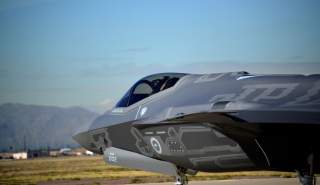Why America's 6th-Generation Fighter (What Comes After the F-35) Could Be a Game Changer
The Pentagon's 6th Generation Fighter may be stealthy and will likely have next-generation computers, electronic warfare technology, speed, weapons and sensors.
Fighter jets in 20-years may likely contain the next-generation of stealth technology, electronic warfare advanced, sophisticated computer processing and algorithms, increased autonomy, hypersonic weapons and so-called "smart-skins" where sensors are built into the side of the aircraft itself.
Some of these characteristics may have been on display earlier this year when Northrop Grumman's SuperBowl AD revealed a flashy first look at its rendering of a new 6th-generation fighter jet. Northrop is one of a number of major defense industry manufacturers who will bid for a contract to build the new plane - when the time is right.
The new aircraft, engineered to succeed the 5th-generation F-35 Joint Strike Fighter and explode onto the scene by the mid 2030s, is now in the earliest stages of conceptual development with the Air Force and Navy. The two services are now working together on early conceptual discussions about the types of technologies and capabilities the aircraft will contain. While the Air Force has not yet identified a platform for the new aircraft.
The Navy's new aircraft will, at least in part, replace the existing inventory of F/A-18 Super Hornets which will start to retire by 2035, Navy officials said.
The Navy vision for a future carrier air wing in 2040 and beyond is comprised of the carrier-launched variant of the Joint Strike Fighter, the F-35C, and legacy aircraft such as the EA-18G Growler electronic jamming aircraft.
Also, around this time is when Navy planners envision its 6th generation aircraft to be ready, an aircraft which will likely be engineered for both manned and unmanned missions.
Technologies are rapidly advancing in coatings, electromagnetic spectrum issues, maneuvering, superiority in sensing the battlespace, communications and data links, Navy leaders have said.
(This first appeared in Scout Warrior here.)
Navy officials also add that the Navy is likely to develop new carrier-launched unmanned air vehicles other than UCLASS in coming years as well.
Analysts have speculated that as 6th generation developers seek to engineer a sixth-generation aircraft, they will likely explore a range of next-generation technologies such as maximum sensor connectivity, super cruise ability and an aircraft with electronically configured “smart skins.”
Maximum connectivity would mean massively increased communications and sensor technology such as having an ability to achieve real-time connectivity with satellites, other aircraft and anything that could provide relevant battlefield information
The new aircraft might also seek to develop the ability to fire hypersonic weapons, however such a development would hinge upon successful progress with yet-to-be-proven technologies such as scramjets traveling at hypersonic speeds. Some tests of early renderings of this technology have been tested successfully and yet other attempts have failed.
Super cruise technology would enable the new fighter jet to cruise at supersonic speeds without needing afterburner, he explained.
Smart aircraft skins would involve dispersing certain technologies or sensors across the fuselage and further integrating them into the aircraft itself, using next-generation computer algorithms to organize and display information for the pilot.
Smart skins with distributed electronics means that instead of having systems mounted on the aircraft, you would have apertures integrated on the skin of the aircraft, analysts have said.
This could reduce drag, increase speed and maneuverability while increasing the technological ability of the sensors.
It is also possible that the new 6th-generation fighter could use advanced, futuristic stealth technology able to enable newer, more capable air defenses. The air defenses of potential adversaries are increasingly using faster computing processing power and are better networked together, more digital, able to detect a wider range of frequencies and able to detect stealthy aircraft at farther distances.
The new 6th-generation fighter will also likey fire lasers and have the ability to launch offensive electronic attacks.
Kris Osborn became the Managing Editor of Scout Warrior in August of 2015. His role with Scout.com includes managing content on the Scout Warrior site and generating independently sourced original material. Scout Warrior is aimed at providing engaging, substantial military-specific content covering a range of key areas such as weapons, emerging or next-generation technologies and issues of relevance to the military. Just prior to coming to Scout Warrior, Osborn served as an Associate Editor at the Military.com. Osborn previously served at the Pentagon as a Highly Qualified Expert with the Office of the Assistant Secretary of the Army - Acquisition, Logistics & Technology. Osborn has also worked as an anchor and on-air military specialist at CNN and CNN Headline News. This story originally appeared in Scout Warrior.

